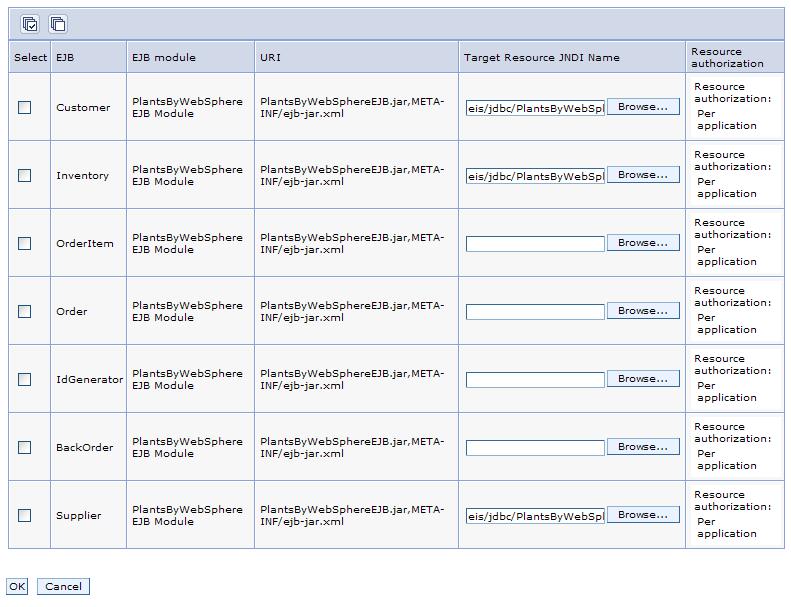2.x CMP bean data sources
Use this page to designate how the container-managed persistence (CMP) 2.x beans of an application map to data sources that are available to the application.
To view this console page, click...
Applications | Enterprise Applications | application | 2.x CMP bean data sources


Guidelines for using this console page:
- The page displays a table that depicts the 2.x CMP bean contents of your application.
- Each table row corresponds to a CMP bean within a specific EJB module. A row shows the JNDI name of the data source mapping target of the bean only if you bound them together during application assembly. For every data source that is displayed, you see the corresponding security configuration.
- To set your mappings:
- Select a row. Be aware that if you check multiple rows on this page, the data source mapping target that you select in step 2 applies to all of those CMP beans.
- Click Browse to select a data source from the new page that is displayed, the Available Resources page. The Available Resources page shows all data sources that are available mapping targets for your CMP beans.
- Click Apply. The console displays the 2.x CMP bean data sources page again. In the rows that you previously selected, you now see the JNDI name of the new resource mapping target.
- Before you click OK to save your new configuration, set the security parameters for the data source. Use the following steps.
- To define data source security:
- Select a row. Be aware that if you check multiple rows on this page, the security settings that you select later apply to all of those data sources.
- Select either Container or Application from the displayed list. Container-managed authorization indicates that WebSphere Application Server performs signon to the data source. Application-managed authorization indicates that the enterprise bean code performs signon. Click Apply.
- To modify the authorization method of a data source with container-managed authorization, you have three options: None, Default, or Custom login configuration. The reconfiguring process differs slightly for each option:
- If you select None:
- Determine which data source configurations to designate with no authentication method.
- Select the appropriate table rows.
- Select None from the list of authentication method options that precede the table.
- Click Apply.
- If you select Default:
- Determine which data source configurations to designate with the WebSphere Application Server DefaultPrincipalMapping login configuration. You must apply this option to each data source individually if you want to designate different authentication data aliases. See the "J2EE Connector security" information center topic for more information on the default mapping configuration.
- Select the appropriate table rows.
- Select Use default method from the list of authentication method options that precede the table.
- Select an authentication data entry or alias from the list.
- Click Apply.
- If you select Custom login configuration:
- Determine which data source configurations to designate with a custom JAAS login configuration. See the "J2EE Connector security" information center topic for more information on custom JAAS login configurations.
- Select the appropriate table row.
- Select Use custom login configuration from the list of authentication method options that precede the table.
- Select an application login configuration from the list.
- Click Apply.
- To edit the properties of the custom login configuration, click Mapping Properties in the table cell.
- Repeat all of the previous steps as necessary.
- Click OK to save your work. You now return to the general configuration page for your enterprise application.
Table column heading descriptions:
- Select
Select the check boxes of the rows to edit.
- EJB
The name of an enterprise bean in the application.
- EJB Module
The name of the module that contains the enterprise bean.
- URI
Specify location of the module relative to the root of the application EAR file.
- JNDI name
The Java Naming and Directory Interface (JNDI) name of the data source that is configured for the enterprise bean.
Data type String
- Resource authorization
The authorization type and the authentication method for securing the data source.
Related tasks
Configure J2EE applications
Related Reference
Administrative console buttons
Administrative console page features
Reference topic